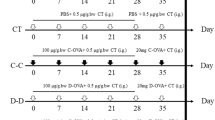Abstract
Egg allergy has been reported as the most prevalent food hypersensitivity in the children. The major egg allergens were found in the egg white. Ovalbumin (OVA) is the major protein in egg white, comprising 54% of its total protein content. OVA has been widely used in experimental animal models of inhalant and dietary allergies, but its allergy mechanism is not clearly identified. In this study, OVA induces transcription factor nuclear factor-κB (NF-κB) and interferon regulatory factor 3 (IRF3) activation, resulting in the expression of genes associated with NF-κB and IRF3 activation such as cyclooxygenase-2, inducible nitric oxide synthase, regulated on activation normal T cell expressed and secreted, and interferon-gamma inducible protein 10. These results suggest that OVA can induce inflammation by lowering host defense.
Similar content being viewed by others
References
Mine Y, Yang M. Recent advances in the understanding of egg allergens: Basic, industrial, and clinical perspectives. J. Agr. Food Chem. 56: 4874–4900 (2008)
Stevens L. Egg white proteins. Comp. Biochem. Physiol. B 100: 1–9 (1991)
Astwood JD, Leach JN, Fuchs RL. Stability of food allergens to digestion in vitro. Nat. Biotechnol. 14: 1269–1273 (1996)
Fu TJ, Abbott UR, Hatzos C. Digestibility of food allergens and nonallergenic proteins in simulated gastric fluid and simulated intestinal fluid-a comparative study. J. Agr. Food Chem. 50: 7154–7160 (2002)
Donovan CE, Mark DA, He HZ, Liou HC, Kobzik L, Wang Y, De Sanctis GT, Perkins DL, Finn PW. NF-κB/Rel transcription factors: c-Rel promotes airway hyperresponsiveness and allergic pulmonary inflammation. J. Immunol. 163: 6827–6833 (1999)
Xu S, Xu Y, Zhang Z, Ni W, Chen S. Effect of nuclear factor-κB on airway remodeling in asthmatic rats. J. Huazhong Univ. Sci. Technolog. Med. Sci. 24: 13–18 (2004)
Yang L, Cohn L, Zhang DH, Homer R, Ray A, Ray P. Essential role of nuclear factor kappa B in the induction of eosinophilia in allergic airway inflammation. J. Exp. Med. 188: 1739–1750 (1998)
Baldwin AS Jr. The NF-κB and I κB proteins: New discoveries and insights. Annu. Rev. Immunol. 14: 649–683 (1996)
Baeuerle PA, Baltimore D. NF-κB: Ten years after. Cell 87: 13–20 (1996)
Karin M, Ben-Neriah Y. Phosphorylation meets ubiquitination: The control of NF-κB activity. Annu. Rev. Immunol. 18: 621–663 (2000)
Au WC, Moore PA, Lowther W, Juang YT, Pitha PM. Identification of a member of the interferon regulatory factor family that binds to the interferon-stimulated response element and activates expression of interferon-induced genes. P. Natl. Acad. Sci. USA 92: 11657–11661 (1995)
Lin R, Heylbroeck C, Pitha PM, Hiscott J. Virus-dependent phosphorylation of the IRF-3 transcription factor regulates nuclear translocation, transactivation potential, and proteasome-mediated degradation. Mol. Cell. Biol. 18: 2986–2996 (1998)
Yoneyama M, Suhara W, Fukuhara Y, Fukuda M, Nishida E, Fujita T. Direct triggering of the type I interferon system by virus infection: Activation of a transcription factor complex containing IRF-3 and CBP/p300. EMBO J. 17: 1087–1095 (1998)
Lin R, Heylbroeck C, Genin P, Pitha PM, Hiscott J. Essential role of interferon regulatory factor 3 in direct activation of RANTES chemokine transcription. Mol. Cell. Biol. 19: 959–966 (1999)
Youn HS, Lee JY, Saitoh SI, Miyake K, Kang KW, Choi YJ, Hwang DH. Suppression of MyD88- and TRIF-dependent signaling pathways of Toll-like receptor by (−)-epigallocatechin-3-gallate, a polyphenol component of green tea. Biochem. Pharmacol. 72: 850–859 (2006)
Youn HS, Lee JY, Fitzgerald KA, Young HA, Akira S, Hwang DH. Specific inhibition of MyD88-independent signaling pathways of TLR3 and TLR4 by resveratrol: Molecular targets are TBK1 and RIP1 in TRIF complex. J. Immunol. 175: 3339–3346 (2005)
Youn HS, Saitoh SI, Miyake K, Hwang DH. Inhibition of homodimerization of Toll-like receptor 4 by curcumin. Biochem. Pharmacol. 72: 62–69 (2006)
Youn HS, Lee JY, Saitoh SI, Miyake K, Hwang DH. Auranofin, as an anti-rheumatic gold compound, suppresses LPS-induced homodimerization of TLR4. Biochem. Bioph. Res. Co. 350: 866–871 (2006)
Park SJ, Shin HJ, Youn HS. Parthenolide inhibits TRIF-dependent signaling pathway of Toll-like receptors in RAW264.7 macrophages. Mol. Cell. 31: 261–265 (2011)
Park SJ, Park HJ, Kim SJ, Shin HJ, Min IS, Koh KO, Kim DY, Youn HS. Suppression of the TRIF-dependent signaling pathway of Toll-like receptors by (E)-isopropyl 4-oxo-4-(2-oxopyrrolidin-1-yl)-2-butenoate. BMB Rep. 44: 468–472 (2011)
Hacker H, Karin M. Regulation and function of IKK and IKKrelated kinases. Sci. STKE 2006: RE13 (2006)
Hori M, Kita M, Torihashi S, Miyamoto S, Won KJ, Sato K, Ozaki H, Karaki H. Upregulation of iNOS by COX-2 in muscularis resident macrophage of rat intestine stimulated with LPS. Am. J. Physiol. Gastrointest. Liver Physiol. 280: G930–G938 (2001)
Servant MJ, Grandvaux N, Hiscott J. Multiple signaling pathways leading to the activation of interferon regulatory factor 3. Biochem. Pharmacol. 64: 985–992 (2002)
Uematsu S, Akira S. Toll-like receptor and innate immunity. Seikagaku 79: 769–776 (2007)
Takeda K. Toll-like receptor. Nihon Rinsho Meneki Gakkai Kaishi 28: 309–317 (2005)
Kumar H, Kawai T, Akira S. Pathogen recognition by the innate immune system. Int. Rev. Immunol. 30: 16–34 (2011)
McWhirter SM, Fitzgerald KA, Rosains J, Rowe DC, Golenbock DT, Maniatis T. IFN-regulatory factor 3-dependent gene expression is defective in Tbk1-deficient mouse embryonic fibroblasts. P. Natl. Acad. Sci. USA 101: 233–238 (2004)
Wang J, Sampson HA. Food allergy: Recent advances in pathophysiology and treatment. Allergy Asthma Immunol. Res. 1: 19–29 (2009)
Bashir ME, Louie S, Shi HN, Nagler-Anderson C. Toll-like receptor 4 signaling by intestinal microbes influences susceptibility to food allergy. J. Immunol. 172: 6978–6987 (2004)
Zhu FG, Kandimalla ER, Yu D, Agrawal S. Oral administration of a synthetic agonist of Toll-like receptor 9 potently modulates peanutinduced allergy in mice. J. Allergy Clin. Immunol. 120: 631–637 (2007)
Author information
Authors and Affiliations
Corresponding author
Rights and permissions
About this article
Cite this article
Youn, HS. Ovalbumin induces nuclear factor-κB and interferon regulatory factor 3 activation. Food Sci Biotechnol 22, 1–5 (2013). https://doi.org/10.1007/s10068-013-0227-1
Received:
Revised:
Accepted:
Published:
Issue Date:
DOI: https://doi.org/10.1007/s10068-013-0227-1




